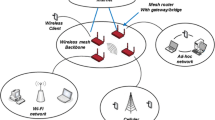Abstract
A new link layer protocol, quality of service hybrid multi channel protocol (QoS–HMCP), that takes into account the need for QoS support in multi-channel multi-interface wireless mesh networks (MCMI–WMNs) is proposed in this paper. QoS–HMCP protocol retains most properties of enhanced distributed channel access (EDCA) mechanism, defined by the 802.11 standard, as well as the basic mechanisms of HMCP protocol. To achieve good network performances with QoS–HMCP protocol in MCMI network, it was necessary to precisely define the channel coordination and procedure for the medium competition of EDCA functions (EDCAFs) after the expiration of interval of time within which a particular EDCAF has the right to initiate data exchange sequences onto the wireless medium—transmission opportunity. Taking into consideration the previously defined conditions, four versions of QoS–HMCP protocol are proposed in this paper. These versions were compared with each other and with basic HMCP with regard to the throughput of user data and delay through the network. The four versions of the QoS–HMCP protocol, multi channel routing (MCR) protocol and chosen metric were implemented in Glomosim simulator. The results have shown that implementation of QoS–HMCP protocol in MCMI–WMN resulted in a very small delay for voice and video traffic, while low-priority traffic categories (best effort and background) were still able to access the media.





Similar content being viewed by others
References
Akyildiz, I. F., & Wang, X. (2005). A survey on wireless mesh networks. IEEE Communications Magazine, 43(9), S23–S30.
Zhang, Y., Luo, J., & Hu, H. (2007). Wireless mesh networking: Architectures, protocols and standards. Boca Raton: Auerbach Publications (CRC Press).
IEEE Std. 802.11-2012. (2012). Wireless LAN medium access control (MAC) and physical layer (PHY) specifications. IEEE.
Kyasanur, P., & Vaidya, N. (2005). Routing and interface assignment in multi-channel multi-interface wireless networks. IEEE Wireless Communications and Networking Conference, 4, 2051–2056.
Kyasanur, P., So, J., Chereddi, C., & Vaidya, N. (2006). Multi-channel mesh networks: Challenges and protocols. IEEE Wireless Communications Magazine, 13(2), 30–36.
Kyasanur, P., & Vaidya, N. H. (2006). Routing and link-layer protocols for multi-channel multi-interface ad hoc wireless networks. ACM SIGMOBILE MC2R, 10, 31–43.
Malnar, M., Neskovic, N., & Neskovic, A. (2014). Novel power-based routing metrics for multi-channel multi-interface wireless mesh networks. Wireless Networks, 20(1), 41–51.
Glomosim simulator. Resource document. http://pcl.cs.ucla.edu/projects/domains/glomosim.htm.
Crichigno, J., Wu, M.-Y., & Shu, W. (2008). Protocols and architectures for channel assignment in wireless mesh networks. Ad Hoc Networks, 6(7), 1051–1077.
Ding, Y., & Xiao, L. (2011). Channel allocation in multi-channel wireless mesh networks. Computer Communications, 34(7), 803–815.
Raniwala, A., Gopalan, K., & Chiueh, T. (2004). Centralized channel assignment and routing algorithms for multi-channel wireless mesh networks. Mobile Computing and Communications Review, 8(2), 50–65.
Marina, M., Das, S., & Subramanian, A. (2010). A topology control approach for utilizing multiple channels in multi-radio wireless mesh networks. Computer Networks, 54(2), 241–256.
Ko, B., J., Padhye, J., Misra, V., & Rubenstein, D. (2007). Distributed channel assignment in multi-radio 802.11 mesh networks, IEEE WCNC, 3978–3983.
Ramachandran K., Belding, M., Almeroth C., & Buddhikot M. (2006). Interference-aware channel assignment in multi-radio wireless mesh networks, IEEE INFOCOM, 1–12.
Bahl, P., Chandra, R., & Dunagan, J. (2004). SSCH: slotted seeded channel hopping for capacity improvement in IEEE 802.11 ad-hoc wireless networks, Int. Conf. on Mobile computing and networking, 216–230.
Wu, D., Yang, S.-H., Bao, L., & Liu, C. H. (2014). Joint multi-radio multi-channel assignment, scheduling, and routing in wireless mesh networks. Wireless Networks, 20(1), 11–24.
Wu, D., Bao, L., Regan, A., & Talcott, C. (2013). Large-scale access scheduling in wireless mesh networks using social centrality. Journal of Parallel and Distributed Computing, 73(8), 1049–1065.
Andreadis, A., & Zambon, R. (2012). Improving QoS performance in IEEE 802.11e Under Heavy Traffic Loads. International Journal of Wireless Information Networks, 19, 49–61.
Ksentini, A., Nafaa, A., Gueroui, A., & Naimi, M. (2007). ETXOP: a resource allocation protocol for QoS-sensitive services provisioning in 802.11 networks. Performance Evaluation (PEVA), 64(5), 419–443.
Johnson, D. (2007). The dynamic source routing protocol for mobile ad hoc networks for IPv4. RFC 4728 Microsoft Research.
De Couto, S. J., Aguayo, D., Bicket, J., & Morris, R. (2005). A high–throughput path metric for multi-hop wireless routing. Wireless Networks, 11(4), 419–434.
Yang, Y., Wang, J., & Kravets, R. (2006). Load–balanced routing for mesh networks. SIGMOBILE Mobile Computing and Communications review, 10(4), 3–5.
Acknowledgments
This research was supported by the Serbian Ministry of Science and Technological Development number TR320025.
Author information
Authors and Affiliations
Corresponding author
Rights and permissions
About this article
Cite this article
Malnar, M., Neskovic, N. & Neskovic, A. A new quality of service aware multi-channel multi-interface link layer protocol for wireless mesh networks. Wireless Netw 21, 727–738 (2015). https://doi.org/10.1007/s11276-014-0818-7
Published:
Issue Date:
DOI: https://doi.org/10.1007/s11276-014-0818-7




